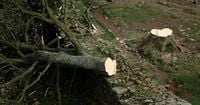In a case that has drawn widespread outrage and grief, two men have been convicted of cutting down the beloved Sycamore Gap tree in northern England. The tree, located along the historic Hadrian's Wall, was felled in a brazen act of vandalism that prosecutors described as "mindless" and "moronic." The Newcastle Crown Court jury found Daniel Graham, 39, and Adam Carruthers, 32, guilty of two counts each of criminal damage on May 9, 2025, after deliberating for just over five hours across two days.
The infamous incident occurred on the night of September 27, 2023, as Storm Agnes raged across the region. Graham had messaged Carruthers, suggesting they prepare their chainsaws for some work. However, instead of clearing fallen trees, the two men drove from their homes in Cumbria to the iconic site with the intent to cut the Sycamore Gap tree down. Prosecutors presented a grainy video from Graham's phone, showing one of the men cutting down the tree while the other filmed the act. This footage, along with digital evidence tracking their movements to the site, played a crucial role in securing their conviction.
The Sycamore Gap tree, estimated to be nearly 200 years old, had stood as a picturesque landmark, famously featured in Kevin Costner's 1991 film "Robin Hood: Prince of Thieves." It became a gathering spot for tourists, photographers, and couples seeking a romantic backdrop for proposals. Chief Crown Prosecutor Gale Gilchrist remarked, "For over a century, Sycamore Gap has been an iconic natural landmark in the northeast of England, bringing immeasurable joy to those visiting the area. In just under three minutes, Graham and Carruthers ended its historic legacy in a deliberate and mindless act of destruction."
During the trial, jurors learned that the tree was not only a beloved local feature but also a symbol of the region's natural heritage. The felling of the tree sparked a wave of grief, with many likening its loss to that of a close friend or family member. Carruthers, in a baffling statement after the event, expressed confusion over the public's reaction, saying, "It was just a tree," and described the sentiment as "almost as if someone had been murdered." His dismissive comments only fueled the outrage surrounding the incident.
Both men showed no visible reaction when the verdict was read. Justice Christina Lambert ordered them held in custody until their sentencing, which is scheduled for July 15, 2025. The maximum penalty for criminal damage in this case is ten years in prison. Prosecutors initially valued the tree at over £620,000 (approximately $830,000), but these figures are now under review. Damage to the ancient wall was estimated at £1,100 (around $1,500).
Graham and Carruthers, who had been friends for about three years, both denied involvement during the trial. Graham claimed he was at home, while Carruthers maintained he was not responsible for the tree's felling. However, evidence presented by the prosecution indicated that the two men had been in contact and reveling in the media attention following the tree's destruction. Text messages exchanged the day after the incident showed them excitedly discussing the tree's viral fame, with Graham stating, "It's gone viral. It is worldwide," as they laughed about the public outcry.
The prosecution painted a picture of two men who, in a misguided attempt at humor, committed an act that would lead to widespread condemnation. Richard Wright, a prosecutor in the case, suggested that the men cut down the tree for "a bit of a laugh" without considering the repercussions of their actions. He described their behavior as the "arboreal equivalent of mindless thuggery," emphasizing the senseless nature of the crime.
As the trial unfolded, it became clear that the tree's destruction had not only impacted the local community but had resonated with people across the country and beyond. The National Trust, which manages the site, expressed gratitude to the prosecutors and police for their efforts in bringing the perpetrators to justice. A spokesperson stated, "The needless felling of the Sycamore Gap tree shocked people around the country and overseas, demonstrating the powerful connection between people and our natural heritage."
Despite the tree's loss, there are signs of hope. Last summer, new shoots were reported emerging from the stump, fueling optimism that the iconic tree might regenerate itself. The National Trust and Northumberland National Park Authority have also been working to nurture saplings grown from seeds collected at the site. These saplings, referred to as "trees of hope," are being distributed to various causes across the UK, including a motor neurone disease center and in memory of those who have passed.
As the community reflects on the impact of the Sycamore Gap tree, many are left pondering the broader implications of such senseless acts of vandalism on nature and heritage. The story of the tree, now intertwined with the narrative of its destruction, serves as a poignant reminder of the need to protect and cherish our natural landmarks. The legacy of the Sycamore Gap tree, once a symbol of beauty and joy, has transformed into a call for awareness and responsibility towards the environment.
As the sentencing date approaches, the community continues to grapple with the emotional fallout of this incident. The Sycamore Gap tree may be gone, but its memory lives on in the hearts of those who cherished it. The hope for regeneration and the future of similar natural landmarks rests in the hands of those who recognize their value and work to preserve them for generations to come.






